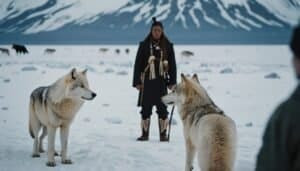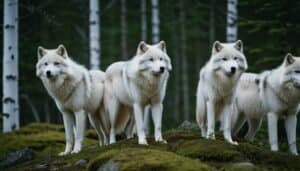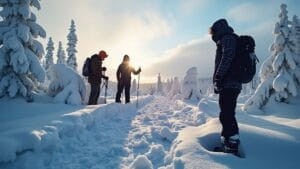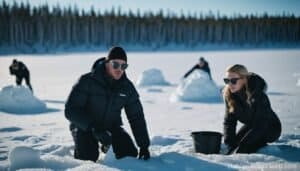Introduction
The Arctic, a vast and pristine region, attracts tourists seeking its unique wildlife and stunning landscapes. Among the many species inhabiting this remote area, wolves hold a special fascination. However, the increasing influx of tourists poses several potential impacts on these elusive predators
This article will explore how human presence affects wolf behavior, the direct impacts on their habitats, the influence of noise pollution, and documented cases of human-wolf conflicts. Additionally, we’ll discuss conservation measures and the roles of tour operators in mitigating these impacts, aiming to balance tourism and wildlife preservation effectively
Effects of Increased Human Presence on Wolf Behavior
Human presence in the Arctic has significantly increased due to tourism, leading to noticeable changes in the behavior of wolves, a key species in this fragile ecosystem. The effects of this increased human presence are multifaceted, impacting hunting patterns, social structures, and general wolf behavior
Changes in Hunting Patterns
Wolves are highly adaptable predators, but their hunting patterns can be disrupted by the presence of humans. Increased tourism activities often result in wolves modifying their hunting strategies. For instance, wolves may avoid areas frequented by humans, leading to shifts in their hunting grounds
This avoidance behavior can force wolves to hunt in less optimal areas, impacting their prey availability and hunting success rates. A study by The Wildlife Society (2018) found that wolves in heavily toured areas tend to have reduced hunting success due to frequent disturbances, leading to decreased pack cohesion and increased energy expenditure
Moreover, human presence can cause wolves to alter their daily activity patterns. Typically, wolves are crepuscular, being most active during dawn and dusk. However, in regions with significant tourist activity, wolves may become more nocturnal to avoid human encounters. This shift not only affects their hunting efficiency but also disrupts the natural predator-prey dynamics in the ecosystem
Altered Social Structures
Wolf social structures are complex and depend heavily on stable pack dynamics. The presence of humans can disrupt these social structures in several ways. For example, the constant disturbance from tourists can lead to increased stress levels among wolves
Elevated stress can impact reproductive success, leading to smaller litter sizes and lower pup survival rates. According to a study published in the Journal of Wildlife Management (2019), stress-induced reproductive failures were more common in wolf populations exposed to high levels of human activity
In addition to reproductive impacts, the disruption caused by human presence can lead to the breakdown of pack cohesion. Wolves rely on strong social bonds and clear hierarchies to function effectively as a pack
However, increased human disturbances can lead to the dispersion of pack members, weakening these bonds and making it more difficult for the pack to hunt and defend their territory effectively. Fragmented packs are more vulnerable to intrusions by rival packs, which can lead to increased mortality rates and further destabilize wolf populations
Another critical aspect is the effect on juvenile wolves. Young wolves learn essential survival skills from adult pack members. Frequent human disturbances can reduce the time adults spend mentoring juveniles, impacting their development and survival skills. This lack of proper upbringing can lead to higher mortality rates among young wolves, further threatening the stability and future of wolf populations in the Arctic
Human presence also brings the risk of habituation, where wolves become accustomed to humans and lose their natural fear
This habituation can lead to dangerous situations for both wolves and humans. Habituated wolves may approach tourist areas seeking food, increasing the risk of conflicts and potential harm to both parties. Preventing habituation is crucial for maintaining the natural behavior of wolves and ensuring their safety as well as that of humans
Efforts to mitigate these impacts include the establishment of tourism guidelines and regulations designed to minimize disturbances. For example, controlled access to sensitive wolf habitats and strict rules on wildlife interactions can help reduce the stress and disruption caused by human presence
Additionally, educating tourists about the importance of maintaining a respectful distance from wildlife and avoiding actions that could alter natural behaviors is essential
Overall, the effects of increased human presence on wolf behavior are profound and multifaceted. The disruption of hunting patterns, alteration of social structures, and increased stress levels all contribute to the challenges faced by Arctic wolf populations. By understanding these impacts, we can better develop and implement conservation strategies to protect these iconic predators and ensure the sustainability of their populations in the face of growing tourism
Direct Impacts of Tourism on Wolf Habitats
Tourism in the Arctic, while economically beneficial, poses direct threats to the habitats of wolves, a keystone species in this fragile ecosystem. The influx of tourists results in habitat disturbances and impacts on denning sites, both of which have significant repercussions on wolf populations
Habitat Disturbance
Tourism-related activities often lead to the degradation of natural habitats. The construction of infrastructure such as roads, lodges, and observation points disrupts the natural landscape
This fragmentation of habitats forces wolves to alter their territories and movement patterns. According to a study by the Arctic Institute of North America (2020), areas with high tourism infrastructure density showed a notable decrease in wolf territory sizes, as wolves avoided these human-modified landscapes
The presence of tourists also leads to increased foot traffic, which can disturb the ground cover and vegetation that wolves rely on for hunting and shelter. Trampled vegetation reduces the availability of cover for wolves and their prey, leading to increased vulnerability and reduced hunting success
Additionally, the noise and activity associated with tourism can displace prey species, making it harder for wolves to find food. The displacement of prey not only affects the wolves’ ability to hunt but also disrupts the entire food web, as prey species might move into less suitable habitats, affecting their survival rates as well
Another significant aspect of habitat disturbance is pollution. Waste generated by tourists, such as food wrappers, plastic bottles, and other litter, can have detrimental effects on the environment. Not only does this litter pose a direct threat to wildlife through ingestion and entanglement, but it also attracts scavengers
This shift in the balance of local fauna can lead to increased competition for resources, further stressing wolf populations. Moreover, chemical pollutants from vehicles and machinery can contaminate water sources, affecting both wolves and their prey
Impact on Denning Sites
Denning sites are critical for the reproduction and survival of wolf packs. These sites provide shelter for pregnant females and their pups, offering protection from harsh weather conditions and predators. However, increased tourism can significantly impact these vital areas
Wolves typically select secluded and undisturbed areas for denning. The encroachment of tourists into these areas can lead to wolves abandoning their dens, which can have catastrophic effects on pup survival
A study conducted by the Wildlife Conservation Society (2017) found that wolf packs disturbed by human activity during the denning season had a 30% higher rate of den abandonment and pup mortality compared to those in undisturbed areas
Even when wolves do not abandon their dens, the presence of humans nearby can lead to increased stress levels among lactating females. Stress can affect milk production and the overall health of the pups, leading to higher mortality rates
Additionally, disturbances during the critical early weeks when pups are entirely dependent on the den can lead to physical and behavioral issues, impacting their long-term survival and integration into the pack
Efforts to mitigate the impact on denning sites include establishing protected areas where human access is strictly controlled or prohibited during the denning season. Buffer zones around known denning sites can help ensure that these critical areas remain undisturbed
Education and awareness campaigns targeting tourists can also play a crucial role in minimizing disturbances. Informing visitors about the sensitivity of denning sites and the importance of maintaining a respectful distance can significantly reduce the negative impacts of tourism on wolf reproduction
Tourism operators can also contribute to conservation efforts by adhering to guidelines that limit their activities around known wolf habitats, particularly during sensitive periods like the denning season. By collaborating with conservationists and researchers, tourism operators can help monitor wolf populations and adjust their practices to minimize disturbances
Influence of Noise Pollution from Tourism
Noise pollution is a significant byproduct of increased tourism in the Arctic, and it poses a serious threat to wolf populations. Noise from human activities such as transportation, recreational vehicles, and tour groups can disrupt the natural behavior of wolves, affecting their communication and inducing stress responses
Impact on Communication
Wolves rely heavily on vocalizations for communication within the pack. Howls, barks, and whines are essential for maintaining social bonds, coordinating hunting strategies, and marking territory. Noise pollution from tourism can interfere with these vocal communications, leading to miscommunication and disruptions in pack dynamics
A study by the Journal of Animal Ecology (2016) demonstrated that increased ambient noise levels can mask wolf vocalizations, making it difficult for pack members to hear and respond to each other
This masking effect can lead to a breakdown in coordination during hunts, reducing hunting success and impacting the overall health and cohesion of the pack. Wolves may also reduce their vocal activity in noisy environments to avoid detection by humans, which can further hinder their ability to communicate effectively
The impact of noise pollution is particularly pronounced during the breeding season. Pups rely on vocal cues from their parents and other pack members to learn essential survival skills. Disruptions in communication due to noise can impair the pups’ development and reduce their chances of survival
Additionally, noise-induced stress can lead to behavioral changes, such as increased aggression or avoidance behaviors, which can further affect pack dynamics and stability
Stress Responses
Chronic noise pollution can induce significant stress in wildlife, and wolves are no exception
Stress can have a multitude of negative effects on wolves, impacting their physiology, behavior, and overall health. Prolonged exposure to noise pollution can lead to elevated levels of stress hormones such as cortisol, which can suppress the immune system and reduce reproductive success
According to research published in Conservation Biology (2018), wolves exposed to high levels of noise pollution exhibited increased heart rates and altered movement patterns, indicating heightened stress levels. These physiological stress responses can lead to a range of negative outcomes, including decreased reproductive success, impaired growth in juveniles, and increased susceptibility to diseases
Increased stress levels can also lead to changes in habitat use and activity patterns. Wolves may avoid noisy areas, even if those areas are rich in prey, leading to suboptimal habitat use and reduced hunting efficiency. This avoidance behavior can force wolves into less suitable habitats, where they face increased competition for resources and higher risks from human-wildlife conflicts
Efforts to mitigate noise pollution in the Arctic include implementing noise-reduction measures and establishing quiet zones in key wildlife habitats. Regulations limiting the use of noisy recreational vehicles and controlling the volume of human activities can help reduce the impact on wolves and other wildlife
Additionally, educating tourists about the importance of minimizing noise and respecting wildlife can contribute to reducing noise pollution in these sensitive areas
Tour operators can play a crucial role in minimizing noise pollution by adopting quieter, less invasive methods of transportation and guiding. Electric vehicles and non-motorized modes of transport, such as hiking and kayaking, can significantly reduce noise levels in critical wolf habitats. Furthermore, operators can schedule tours to avoid peak activity times for wolves, reducing the likelihood of disturbance
Human-Wolf Conflicts in Arctic Tourist Areas
The increase in Arctic tourism has inevitably led to more frequent interactions between humans and wolves, sometimes resulting in conflicts. These conflicts can have serious implications for both human safety and wolf conservation, necessitating the implementation of preventive measures to mitigate these issues
Documented Incidents
Human-wolf conflicts in Arctic tourist areas have been documented with varying degrees of severity. While wolves generally avoid humans, certain situations can lead to encounters that pose risks to both parties
For instance, habituation to human presence, often due to the availability of food or garbage left by tourists, can reduce wolves’ natural wariness, leading them to approach humans more closely
One notable incident occurred in 2015 in Denali National Park, where a habituated wolf approached a group of tourists, leading to a confrontation that ended with the wolf being euthanized to ensure public safety. Such incidents underscore the dangers of wolves losing their fear of humans, which can result from repeated exposure and the availability of anthropogenic food sources
In other cases, tourists have been known to feed wolves intentionally, further exacerbating the risk of habituation. This behavior not only endangers the tourists but also disrupts the natural foraging patterns of wolves, making them reliant on human-provided food
In 2019, a study published in the journal Biological Conservation highlighted several cases in which wolves had become aggressive towards tourists, primarily in areas where they had been fed or had easy access to human food waste
Preventive Measures
Preventing human-wolf conflicts in Arctic tourist areas requires a combination of education, regulation, and proactive management. Education is a crucial first step in preventing conflicts
Tourists must be informed about the potential dangers of interacting with wolves and the importance of not feeding or approaching them. Many national parks and wildlife reserves have implemented educational programs and signage to inform visitors about appropriate behavior around wildlife
Regulations are another critical component. Enforcing strict guidelines on waste management can significantly reduce the availability of food sources that attract wolves. This includes ensuring that all food waste is stored securely and not left in areas accessible to wildlife. Parks and tourist operators should provide bear-proof bins and ensure that visitors use them properly
Additionally, creating buffer zones around known wolf habitats can help minimize direct interactions. These zones can restrict human access to sensitive areas, particularly during critical times such as the denning and breeding seasons. By limiting human activity in these areas, the likelihood of disturbing wolves and triggering conflicts can be reduced
Proactive management strategies include monitoring wolf populations and their movements to identify potential conflict zones
Wildlife managers can use GPS tracking collars and other technologies to keep track of wolf pack locations and movement patterns. This data can then inform decisions about where to direct tourists and which areas to restrict
In cases where wolves have become habituated to humans, more direct intervention may be necessary. Techniques such as aversive conditioning, where wolves are exposed to negative stimuli when they approach humans or human structures, can help re-instill their natural wariness
In some situations, it may be necessary to relocate problem wolves to areas with less human activity, although this is often considered a last resort due to the stress it places on the animals
Tour operators play a vital role in implementing these preventive measures. By following best practices for wildlife viewing and ensuring that their clients do the same, operators can help minimize disturbances to wolves. This includes maintaining safe distances, using non-intrusive observation techniques, and educating tourists about the importance of respecting wildlife
Conservation Measures to Protect Wolves
Conservation measures are critical in mitigating the adverse effects of tourism on Arctic wolf populations. Effective strategies include regulation and management, as well as the pivotal role of tour operators in implementing these measures
Regulation and Management
Regulation and management are essential components of wolf conservation efforts. Governments and conservation organizations have developed various policies and regulations to protect wolf habitats and reduce human impact
One of the key regulatory measures is the establishment of protected areas where human activities are restricted. These areas serve as safe havens for wolves, ensuring they have undisturbed habitats for hunting, denning, and raising their young
For example, the Arctic National Wildlife Refuge in Alaska provides critical habitat for numerous wildlife species, including wolves. Strict regulations within the refuge limit human access and activities, thereby reducing disturbances to wildlife
Additionally, specific regulations target the direct impacts of tourism. These include guidelines on wildlife viewing distances, noise restrictions, and limits on the number of visitors allowed in sensitive areas. For instance, Yellowstone National Park has implemented guidelines that require visitors to stay at least 100 yards away from wolves, reducing the likelihood of disturbances and potential conflicts
Effective waste management policies are also crucial. Regulations requiring proper disposal of food and waste help prevent wolves from becoming habituated to human-provided food sources. National parks and reserves often provide bear-proof trash cans and mandate their use to minimize the risk of attracting wildlife
Another important aspect of regulation is the monitoring and enforcement of these rules. Park rangers and wildlife officers play a crucial role in ensuring compliance with conservation guidelines. Regular patrols, surveillance, and the issuance of fines for violations help maintain the integrity of protected areas and minimize human impact on wolf populations
Role of Tour Operators
Tour operators play a significant role in wolf conservation by implementing best practices and educating tourists. Their involvement is crucial in ensuring that tourism activities are conducted responsibly and sustainably
One of the primary ways tour operators contribute to conservation is through the development and adherence to wildlife viewing guidelines. These guidelines help minimize disturbances to wolves and other wildlife
For example, operators can use non-intrusive observation techniques, such as binoculars and telescopes, to allow tourists to view wolves from a safe distance without causing stress or disruption
Tour operators also have the responsibility to educate tourists about the importance of respecting wildlife and the environment. Pre-trip briefings and informational materials can inform tourists about the potential impacts of their actions and the importance of following guidelines. This education helps foster a culture of responsible tourism, where visitors are more likely to adhere to conservation practices
Additionally, tour operators can adopt sustainable practices to reduce their environmental footprint. This includes using eco-friendly transportation options, such as electric vehicles or non-motorized modes of transport like hiking and kayaking. By reducing noise and pollution, these practices help protect wolf habitats and minimize disturbances
Collaboration between tour operators and conservation organizations is another effective strategy. Joint initiatives can include habitat restoration projects, wildlife monitoring programs, and conservation education campaigns
For instance, some tour operators participate in citizen science programs, where tourists can assist with data collection on wolf sightings and behavior. This data can then be used by researchers to better understand wolf populations and inform conservation strategies
Financial contributions from tour operators can also support conservation efforts. Many operators allocate a portion of their profits to fund conservation projects, such as habitat restoration, anti-poaching initiatives, and community outreach programs. By investing in conservation, tour operators help ensure the long-term survival of wolf populations and the overall health of the Arctic ecosystem
Combined Effects of Climate Change and Tourism
The Arctic region is experiencing rapid changes due to climate change, which, combined with increasing tourism, poses significant challenges for wolf populations. The interplay between these factors affects prey availability and has long-term ecological impacts, exacerbating the pressures on Arctic wolves
Changes in Prey Availability
Climate change is altering the Arctic landscape, impacting the availability and distribution of prey species crucial for wolf survival
Warmer temperatures and changing precipitation patterns affect the habitats and populations of species such as caribou, muskoxen, and Arctic hares, which are primary prey for wolves. As these prey populations shift, wolves must adapt their hunting strategies and territories, often leading to increased energy expenditure and reduced hunting success
A study published in Global Change Biology (2019) found that caribou populations, a key prey species for Arctic wolves, have declined by nearly 50% in some regions due to changing climatic conditions
This decline forces wolves to travel greater distances to find food, increasing the risk of encountering human activity and the associated disturbances. The scarcity of prey can also lead to increased competition among wolves and other predators, further straining their populations
Tourism exacerbates these challenges by disrupting the natural behaviors of prey species. Human presence can cause prey animals to alter their movement patterns, making it harder for wolves to track and hunt them effectively. For instance, caribou may avoid areas with high tourist activity, forcing wolves to follow them into less suitable habitats
Additionally, noise pollution from tourism can stress prey species, affecting their health and reproduction, which in turn impacts the food supply for wolves
Long-Term Ecological Impacts
The combined effects of climate change and tourism are not limited to immediate changes in prey availability; they also have long-term ecological impacts on the Arctic ecosystem and wolf populations. These impacts include alterations in species interactions, habitat fragmentation, and ecosystem resilience
One significant long-term impact is the potential for trophic cascades. Wolves are apex predators, playing a crucial role in maintaining the balance of the ecosystem. Changes in wolf populations can have cascading effects on other species and the overall health of the environment
For example, a decline in wolf numbers can lead to an overpopulation of herbivores such as caribou and hares, which can result in overgrazing and degradation of vegetation. This degradation affects not only the prey species but also other wildlife dependent on the same habitats, leading to a loss of biodiversity
Habitat fragmentation caused by both climate change and tourism infrastructure further complicates the situation. Melting ice and permafrost create new water bodies and alter the landscape, while the construction of roads, lodges, and other tourist facilities disrupts natural habitats
Fragmented habitats can isolate wolf populations, reducing genetic diversity and making them more vulnerable to disease and environmental changes. A study in the Journal of Wildlife Management (2020) highlighted the increased risk of inbreeding and genetic bottlenecks in isolated wolf populations, which can lead to reduced resilience and adaptability
Moreover, the cumulative stress from climate change and tourism can affect the reproductive success and health of wolf populations. Chronic stress from habitat disturbances, prey scarcity, and increased human interactions can suppress immune function and reduce reproductive rates
Female wolves may produce smaller litters or have lower pup survival rates, leading to a gradual decline in population numbers over time. According to research published in Conservation Physiology (2018), stress-induced reproductive failures were observed in wolf populations exposed to high levels of human activity and environmental changes
Mitigating these long-term impacts requires a comprehensive approach that addresses both climate change and tourism management. Conservation strategies should focus on preserving and restoring habitats, reducing human disturbances, and enhancing the resilience of wolf populations
This includes protecting critical areas from development, implementing sustainable tourism practices, and supporting climate adaptation measures
Collaborative efforts between governments, conservation organizations, and local communities are essential for effective management. Initiatives such as habitat corridors can help maintain genetic connectivity between isolated wolf populations, while adaptive management practices can ensure that conservation strategies remain effective in the face of changing conditions
Additionally, reducing greenhouse gas emissions and supporting renewable energy sources can help mitigate the broader impacts of climate change on Arctic ecosystems
Conclusion
Arctic tourism, while bringing economic benefits and increased awareness of the region, poses significant threats to wolf populations. The influx of tourists affects wolf behavior, disrupts their habitats, introduces noise pollution, and increases the risk of human-wolf conflicts
These impacts are compounded by climate change, which alters prey availability and exacerbates habitat fragmentation. Effective conservation measures are essential to mitigate these threats. Regulations and management strategies, along with the active role of tour operators, can help protect wolves by minimizing disturbances and promoting responsible tourism practices
Addressing the combined effects of climate change and tourism through integrated and proactive conservation efforts is crucial for ensuring the survival of Arctic wolves and the health of their ecosystems. By balancing tourism and wildlife preservation, we can safeguard the future of these iconic predators in the rapidly changing Arctic landscape










